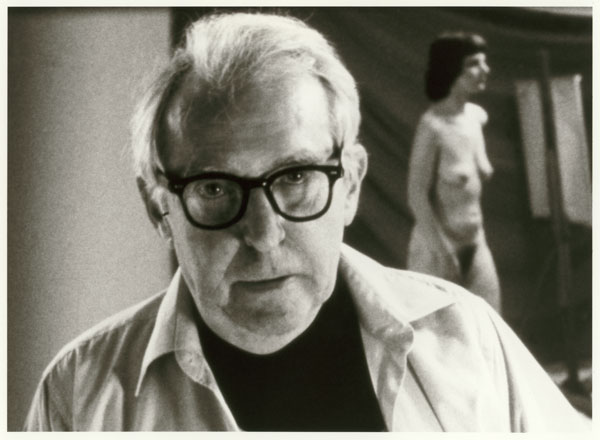Jack Levine’s 1983 painting The Arms Brokers is one of many political protest work he created during his career. The painting features many well-known political figures from the 1980s, including president Ronald Reagan; Alexander Haig, Reagan’s secretary of state from 1980 to 1982; Henry Kissinger, Secretary of State and National Security Advisor under presidents Richard Nixon and Gerald Ford; David Rockefeller, leader of Chase Bank; Admiral Hyman Rickover, known as the Father of the Nuclear Navy; King Saud, the deposed leader of Saudi Arabia; the Ayatollah Khomeini, supreme political and religious leader of Iran through the 1980s; and Leonid Brezhnev, leader of the Soviet Union during the Cold War.

Jack Levine (1915 – 2010)
The Arms Brokers, 1982-83
Oil on canvas
Crystal Bridges Museum of American Art, Bentonville, Arkansas
In Levine’s characteristic satirical style, these political icons appear as shadowy figures gathered together to trade military toys such as planes and nuclear weapons. “I brought the men together with their toys,” Levine stated. “These are the arms brokers – the biggest game in town. They are the people in the world who really matter.”
Levine dedicated much of his career to lambasting political figures and American political and business dealings. He gained attention, and some notoriety, in 1937 for his painting The Feast of Pure Reason, which depicted an American businessman, a police officer, and a politician scheming together like goblins. The Museum of Modern Art acquired the work, but engaged in some debate among the board members as to whether or not they should exhibit it.

Jack Levine, The Feast of Pure Reason, 1937, Courtesy the Museum of Modern Art
Levine was drafted into World War II in 1942 and spent his military service painting camouflage. Upon his return, he created the controversial painting Welcome Home, which depicted a group of Fat Cat politicians gorging on delicacies around a well-appointed table. The work was criticized by President Eisenhower, and gained him the attention of the House Un-American Activities Committee. Levine seems to have reveled in this criticism, later saying, “You get denounced by the president of the United States, you’ve hit the top.”

Jack Levine, Welcome Home, 1946. Courtesy Brooklyn Museum, New York
After the war, when the American art world turned toward Abstract Expressionism and realistic painting was denigrated as passé, Levine resolutely stayed the course. He referred to the Ab Ex painters as “space cadets,” and continued to paint in his signature representational and satiric manner throughout his career. His process was inspired by the Old Masters, particularly Titian and Goya. “I love the Old Masters,” he said. “I don’t care for anybody modern… I want to paint with the dead ones.”
Although he painted other subjects as well, including Biblical scenes and historic Jewish leaders, he continued to focus on what he perceived as political and social ills, ranging from images of Mob bosses in Gangster Funeral, to depictions of Black men being attacked by police dogs in Birmingham ’63.

Jack Levine, Birmingham ’63, Image Courtesy the de Young Museum, San Francisco
“I am primarily concerned with the condition of man,” Levine said. “The satirical direction I have chosen is an indication of my disappointment in man, which is the opposite way of saying that I have high expectations for the human race.”




